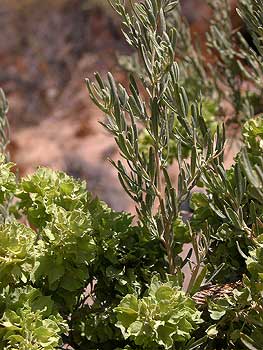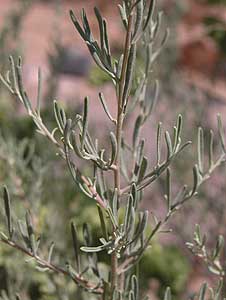 Fourwing Saltbush
Fourwing Saltbush
Atriplex canescens (Pursh) Nutt.
Common Names
Chamise, chamize, chamiso, white greasewood, saltsage, fourwing shadscale, bushy atriplex.
Uses
Rangeland/Grazing: fourwing saltbush is highly palatable browse for most livestock
and big game. It is used primarily in the winter at which time it is high in carotene
and averages about four percent digestible protein. The leaves may be as high as 18
percent total protein. It is grazed by all classes of livestock except horses.
Wildlife: fourwing saltbush provides excellent browse for deer season long. It is a good browse plant for bighorn sheep, antelope, and elk in fall and winter. It is also a food source and excellent cover for sharptail grouse, gray partridge (Huns), sage grouse, and other upland birds, rabbits, songbirds, and small mammals.
Erosion Control: fourwing saltbush makes excellent screens, hedges, and barriers. It is especially useful on saline-sodic soils. It has excellent drought tolerance. It has been planted in highway medians and on road shoulders, slopes, and other disturbed areas near roadways. Because it is a good wildlife browse species, caution is recommended in using it in plantings along roadways. Its extensive root system provides excellent erosion control.
Reclamation: fourwing saltbush is used extensively for reclamation of disturbed sites (mine lands, drill pads, exploration holes, etc,). It provides excellent species diversity for mine land reclamation projects.
 Description
Description
Fourwing saltbush is a polymorphic species varying from deciduous to evergreen,
depending on climate. Its much-branched stems are stout with whitish bark. Mature
plants range from 1 to over 8 feet in height, depending on ecotype and the soil and
climate. Its leaves are simple, alternate, entire, linear-spatulate to narrowly
oblong, canescent (covered with fine whitish hairs) and ½ to 2 inches long. Its root
system is branched and commonly very deep (to 20 feet) when soil depth allows.
Fourwing saltbush is mostly dioecious, with male and female flowers on separate plants. Male flowers are red to yellow and form dense spikes at the ends of the branches. The female flowers are axillary and nondescript. However, some monecious plants may be found within a population. Fourwing saltbush plants can exhibit hermaphroditic characteristics (male and female parts in one flower). The seed is contained in utricles that turn a dull yellow when ripe and may remain attached to the plant throughout winter.
Fourwing saltbush derives its name from the four membranous 'winged' capsules, which encompass the seed. It is most commonly called fourwing saltbush, but is also known as chamise, chamize, chamiso, white greasewood, saltsage, fourwing shadscale, and bushy atriplex.
Adaptation and Distribution
Fourwing saltbush is an important species in the northern salt desert shrub
association. Average annual precipitation in this desert area varies from 6
to 14 inches but is mostly in the 8 to 12 inch range; summers are hot and dry
and winters are normally cold. Fourwing saltbush grows on a wide range of soils
from clays to sands. It does well in soils with high lime content. It can
tolerate soil depths from 10 inches to over 3 feet, but is mostly found in
moderately deep to deep soils. It is able to exist on soils with heavy white or
black alkali concentrations but is not restricted to saline-alkali areas and is
by no means an indicator of these conditions. The plant is found in desert flats,
gravelly washes, mesas, ridges, slopes, and even on sand dunes. It can grow at
elevations from 3,000 to as high as 8,000 feet, but is most likely to be found
at 4,500 to 6,000 feet.
Fourwing saltbrush is distributed throughout the western United States.
Establishment
The seedbed should be weed free and firm. Drilling is the most successful seeding
method but some success has occurred from broadcasting where some method of
covering has been employed. Seed should be covered no deeper than 1 inch.
Seedings have been successful throughout the year but best results are obtained
by seeding in late spring or early summer. Good stands have been obtained by
seeding during the winter as late as January. Seeding rate should be 8 to 10
pounds per acre. De-wing the seed with a hammer mill improves the ease of
handling and enhances germination. Poor stands may result if seed is not
de-winged.
Seed ripens in late August and September and can be collected from September to December by stripping it from dense clusters. They can be stored successfully and remain viable for 6 or 7 years. Some transplanting of 2 or 3 year old nursery stock has been tried but has not been successful.
Management
Planted areas should be kept free of weeds during the first year of establishment.
Proper grazing use on this shrub should be 40% of the total annual growth during
the growing period and 50% during the plant dormancy period. This plant is well
adapted to winter use. Careful management is needed due to the brittle nature of
the twigs. A rotation deferred system of grazing will aid this plant in
producing a maximum yield of forage for livestock.
As a screening plant, this species has a place on drier locations. However; it should not be seeded in heavy foot, horseback, or vehicle travel areas where it would soon be killed due to its brittle nature. In heavy winter deer concentration areas, this plant will be grazed out if additional food sources are not provided.
Pests and Potential Problems
There are no serious pests of fourwing saltbush. Rabbits and other small rodents
are especially damaging to small seedlings.